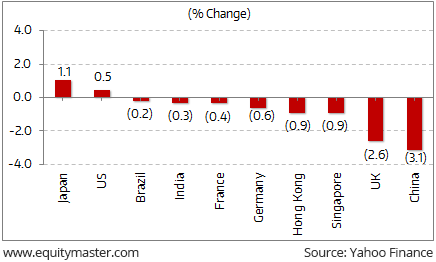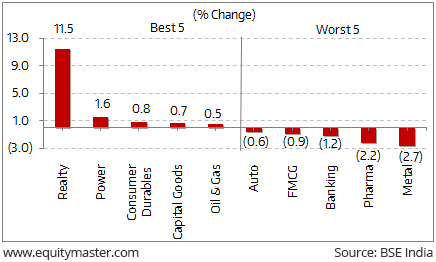Investors were cautious ahead of the first round of the French Presidential elections ending next week. A fall in crude oil prices amidst oversupply concerns also adversely affected Global markets last week. Crude prices fell by 6.4% last week on growing concerns over increasing U.S production affecting OPEC’s attempts to reduce the global oil shortage. US Markets ended 0.5% higher this week.
UK markets ended lower by 2.6% this week after the Government’s surprise call for a national election on Tuesday. Prime Minister Theresa May called for an early vote on June 8, causing equity markets to fall. Retail sales in UK on Friday showed the biggest quarterly fall in seven years as price rise suppressed demand amongst consumers.
Chinese investors have been nervous due to recent decline in steel and coal prices. The latest IMF report on China warned that excessive dependence on credit for economic growth could result in an economic imbalance in the future. The Chinese market ended lower by 3.1% as compared to last week.
Key World Markets During the Week

Back home, Indian stock markets closed lower by 0.3% over the last week. IT and Pharma stocks dragged the markets lower due to global factors currently affecting these two sectors. Recent protectionist policies hinted by US and other global leaders could see IT stocks remaining subdued in the near future.
Meanwhile, the World Bank in latest report has stated that India’s GDP is expected to see uptick from 6.8% in 2016-2017 to 7.2% by current fiscal year and rise further to 7.5% in 2018-19 fiscal. It also forecasted that India’s economic growth will rise slowly to 7.7% in 2019-2020 supported by a recovery in private investments.
BSE Indices During the Week

Now let us discuss some key economic and industry developments during the week gone by.
In news from the goods and services tax (GST) space, the government is now looking to bring variations in GST rates on the same types of products to a minimum.
This is to ensure that the GST structure does not get any more complicated.
Presently, India has adopted a four-tier tax structure of 5%, 12%, 18% and 28% under the GST regime for various products and services.
The rate applicable on most products is decided at 18%. The highest rate has been pegged in the GST law at 40%. Since there is a huge gap between these two rates, many believe the GST structure will undermine the basic tenet of being simple. And the above initiative is aimed at resolving this issue.
How the above development pans out remains to be seen.
Moving on to news about the economy. According to data released by the Central Statistics Office, Wholesale price inflation (WPI) eased to 5.7% in March as compared to 6.6% in February this year.
However, WPI was in the negative zone, at -0.5% in March last year.
The fall in inflation can be attributed mostly to falling oil prices, with the inflation for fuel and power segment coming in at 18.2% in March as compared to 21% for the previous month.
The build up inflation rate in the financial year so far was 5.7% compared to a build up rate of -0.45% in the corresponding period of the previous year.
Since the start of financial year 2016-17, WPI has been rising consistently, so much so that in February it reached to a 4-year high due to rise in fuel inflation (21%) and lower base in the previous year’s index.
Interestingly, core WPI, which has been increasing since July 2016, declined marginally to 2.4% in February 2017 – it was at 28-month high of 2.7% in previous month.
The decline was led by a marked fall in fuel and manufacturing products inflation. While this came as a welcome breather, the same is expected to rise as the cash crunch led by notebandi turns normal. So when consumer spending normalizes, we should all be on our guard for rising inflation.
However, the sharp correction in crude oil prices witnessed over the last week would aid in dousing minerals inflation in March 2017. Moreover, the continued appreciation of the Rupee relative to the US Dollar would dampen the landed cost of imports. In addition to this, the RBI has slowed down the pace of remonetisation in March, which will reduce spending over time.
Such trends are likely to keep the WPI below the 6% mark in the ongoing month.
Moving on to the IT Sector, US President Donald Trump is set to sign an executive order that would tighten the process of issuing the H-1B visas and seek a review of the system for creating an entirely new structure for awarding these visas, the most sought-after by Indian IT firms and professionals.













Leave A Comment